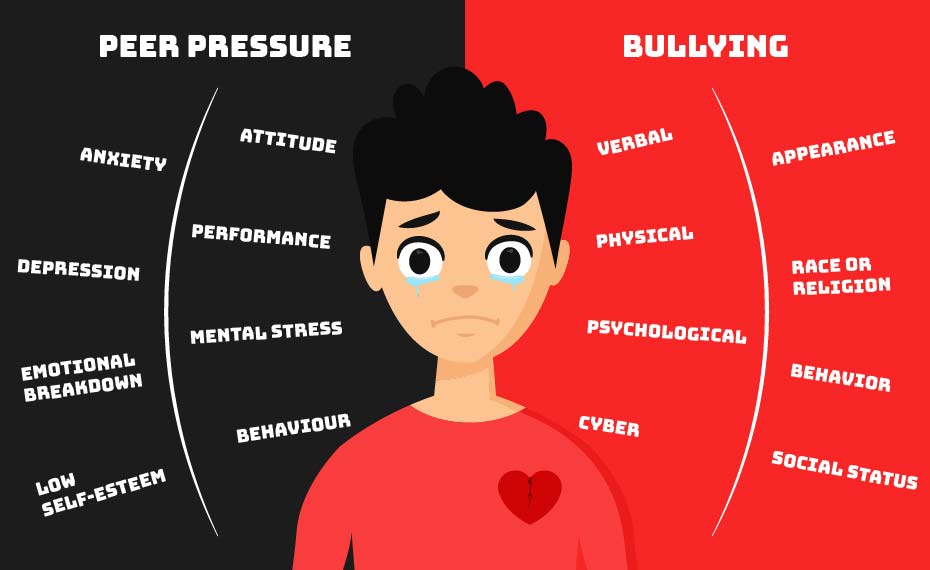Friends can influence a child’s attitudes and behaviors in ways that matter across multiple domains of mental and physical health and well-being. Consider two scenarios. First, your kid wants a certain kind of school bag. Second, when he doesn’t want to go to school without that school bag as his fellow classmates and peers make fun of him for not having it. The former is the case of peer pressure [1] and the latter is of bullying [2]. In such cases of peer pressure and bullying, your child goes through psychological stress and suffer from issues like anxiety, emotional breakdown, depression as well.
In both the cases the child is put under psychological stress and mental pressure. Peer pressure and bullying is a serious problem among school-age children and adolescents. They lead to anxiety, low self-esteem and in worst case mental illness. Mental health issues have always existed but, in recent years, it’s taken on a whole new, and concerning, dimension with more teenagers suffering from anxiety, depression, and psychological stress. With a little knowledge of these issues and ways to deal with them, it becomes even more difficult.
Peer Pressure and Bullying, there is a very fine difference between these two terms.
It is necessary to know the difference as each one can be dealt with differently.
Peer Pressure
People who are of the same age, like classmates, are called peers. When they have a direct influence on an individual, it’s called peer pressure. Peer pressure affects the decision making, behavior and preferences of an individual. While it exists amongst all the age group, it is most common in children and teenagers. Decision making on your own at this age is hard enough, but when peers try to pressure you one way or another it can become tougher.
Peers play a large role in a child’s life. It is important to have friends for the social and emotional development of children. Relying on friends is natural but more often than not they start affecting kid’s better judgement and they do things which they are unsure of or simply not interested otherwise. This is the onset of peer pressure. The influence begins at an early age and increases through the teenage years.
How it arises?
Peer pressure can arise from something as simple as when the child is asking to buy a spider-man school bag because most of the children in the class like spider-man or have the similar bag. We often think of it as another demand and ignore the far sight of this. This pressure of doing things for social acceptance can increase with age and can take the form of peer pressure. Most of the times children do not even know they are into this kind of pressure. They do it because everybody is doing it. There can be various reasons to it, the foremost being social acceptance and validation. The child wants to be liked and to do the right thing. As a parent, you can help your child deal with peer pressure and make good choices at every age and stage.
Types of peer pressure
Peer pressure need not always be negative. It can be positive, negative or both. Consider the case of your child joining a painting class because few other friends are joining. Initially he didn’t join but after joining it proves to be a productive hobby class. In this case, though the decision was influenced by friends, it was for good.
In the second case the child bunks few classes in the school and plays instead because all his friends were doing so. Even though he did not wanted to do it particularly but as all other friends were bunking he thought it was okay to bunk. Hence the peer pressure in this case was a negative one.
Lastly, consider your child is competitive in studies. It is good as the child is good in studies and wants to score good marks but within no time this pressure of performing better than others can stress out the child and can lead to serious health issues like eating and sleeping disorders. Negative peer pressure can affect mental health and lead to stress, anxiety and emotional disorders.
Why it arises?
The reasons for peer pressure can be many. The foremost reason is to fit into a certain group or to look like them. Who likes to befriend a boring person right. Everybody wants to look socially acceptable. In order to fit into a group of people, kids go way out of their comfort zone and do things. There is a constant urge of looking, behaving in a certain way which is considered as cool or trendy amongst their peers which often leads to kids taking pressure of doing things under the influence of peers.
Secondly, the idea that “everyone’s doing it”. Kids don’t want to be left behind. This lead to children getting into peer pressure. There is a fear of missing out (FOMO). In such scenarios, they often ignore their own wish and do what the others are doing.
Finally, the ‘log kya kahenge’ (LKK) syndrome. The fear of people’s judgement grows in children if they try to be different from their peers. They find it very difficult to refuse or to say ’no’ to things because they don’t want their peers to judge them. This too results in peer pressure.
Bullying
Bullying is the use of force, to abuse, humiliate or aggressively dominate a person. It is done intentionally with the purpose of hurting a person physically or mentally. Bullying is habitual and repeated behavior. Two key things to define bullying are, first the imbalance of Power: people who bully use their power—such as physical strength, access to some personal information, popularity to control, harm and bully others. Second, repetition: Bullying behaviors is a repetitive process and can happen more than once.
Any actions which can torture an individual both mentally and physically can be termed as bullting. Few of the actions include making fun, making threats, spreading rumors, humiliating, attacking someone physically or verbally, excluding someone from a group on purpose. Most of the times these actions do not have a particular reason, the bully does it simply because he might be powerful or most popular or the person getting bullied may be weak. The bully might not have any personal avenge with the person.
Bullying is most common amongst kids and teenagers, hence can occur anywhere in their space and can be done by anyone. Any part in or around the school building or home can be a potential place for the bully for bullying. Bullying also takes place in school hallways, bathrooms, on school buses and while waiting for buses, and in classes. Anyone can be a bully, a fellow classmate, a senior, even an adult in the neighborhood sometimes. The most reported bullying cases happens in the school building and while travelling to or from school.
Types of bullying
Bullying can take many forms including
Physical Bullying
When the bully hurts the victim’s body or damages their possessions, it is called physical bullying. Pushing, shoving, hitting, fighting, stealing and destroying property all are types of physical bullying. The bully rarely starts with physical bullying as the first form of bullying the target. Often bullying begins in a different form and later progress to physical violence.
Verbal Bullying
Verbal bullying is any bullying that is conducted by speaking. Calling names, spreading rumors, threatening somebody, humiliating them and making fun of others are all forms of verbal bullying. In most cases, this is the first form of bullying.
Psychological Bullying
Any form of bullying done to disturb the psychological state of the target is psychological bullying. It can include gossiping about or excluding people to make them feel bad about themselves, humiliate, spread rumors, create a pressure to do certain things.
Cyber Bullying
Social media and technology play an indescribable role in our lives. Cyberbullying is the most common type of bullying in recent times. It is the use of technology to harass, threaten, embarrass, or target another person. This includes email, instant messaging, social networking sites (such as Facebook), text messages, and cell phones.
Resources:
Cybercrine Reporting Portal (Govt of India) [Link]
Bullying in school
Bullying in school and the workplace is also referred to as “peer abuse”. Collective bullying is known as mobbing and can include any of the individual types of bullying. Physical, verbal, and relational bullying are most prevalent in primary school and could also begin much earlier whilst continuing into later stages in individuals lives. Cyberbullying is more common in secondary school than in primary school.
Anyone can be a bully. A classmate, a senior kid, even a teacher sometimes can take part in bullying. It can be physical, verbal, psychological or emotional. It can be as simple as boycotting a child or excluding him. This can adversely affect a child’s mental health. It can cause an emotional breakdown and can lower the confidence of the child. As a result, they can suffer from anxiety and depression. Not wanting to go to school at all, not performing well in academics, being traumatized are few of the consequences of bullying in school.
The various factors on which bullies makes fun can be:
- Appearance: Based on how someone looks or on the physical appearance of the victim.
- Behavior: Based on the nature and behavior of the victim.
- Race or religion: Based on caste, religion, culture or the language the victim speaks.
- Social status: often the bully is more popular and powerful than the victim. Hence this becomes on the factors for bullying
How do peer pressure and bullying affect the child?
Peer pressure can stress out the child, inculcate social fears of acceptance, judgement in them. In the long term these start affecting the mental health of the child. It can lead to panic, anxiety, emotional disorder, depression and many more issues. In worst cases it can also lead to bi-polar disorder.
Bullying on the other hand can cause loneliness, depression, anxiety, lead to low self-esteem. Few studies show that bullying also causes maladjustment in young children. A mental health report found that bullying is linked to eating disorders, anxiety, body dysmorphia and other negative psychological effects.
What role does social media and the internet has to play?
Social media and the internet can expand our pool of peers. There’s a strong temptation to compare our lives to other people’s curated Instagram or Facebook feeds. This can affect our perception of ‘normal’ and can lead to feelings of inadequacy and wanting to conform. In the past, peer pressure was restricted only to offline environments such as school, whereas today social media plays a key role in defining the standards of living and hence create the pressure. Similarly, cyber bullying is the most common form of bullying these days.
What can be done?
When it comes to helping the child deal with peer pressure and bullying, everyone surrounding the child play an important role. Firstly, since both the problems primarily start from the school, the school has an important role in ensuring that no child suffer from problems like peer pressure and bullying. Secondly, if observed at the correct time, parents can help their child the most in dealing with peer pressure and the problem of bullying. Finally, children have to help themselves to fight these.
How school can help?
Teachers have to make sure there is no competition amongst the students to perform the best in the exams. A child himself should be his only competition. No child comes under the influence of other children. Teachers must teach the idea of individuality to the students. Apart from this, there must be strict rules in the school against bullying. School can conduct workshops for the students about the same. They should educate and council them to deal with peer pressure and bullying.
How can parents help?
As parents, you need different skills for different roles and stages in your child’s life. More often than not, the child is scared to open up about issues like peer pressure and bullying in the first place. Reasons for this can be several. In such cases the parents have to be aware and observe any kind of abnormal behavior. As for dealing with peer pressure, it is important to let your child know that it is okay to say ‘no’. If they don’t want to do something, they can refuse to do it. They don’t always have to be liked by their own peers and seek validation from them. As for the case of bullying your first instinct as a parent will probably be that you want to go to school and speak to the teachers or the child’s parents of the bully.
Most important is to teach your child skills to deal with peer pressure and bullies themselves. You can play an important role in boosting your child’s confidence. Teach your child that everyone is unique and special in their own way. It is not necessary to impress everyone every time. If they are being teased about how they look and act, let them also laugh with the bully. As soon as a bully loses its power over someone they will stop. Have a transparent relationship with your child. Let your child know they can talk to you about anything. Make time for your child to ensure that you are aware of what your child is going through. Show interest in their school activities. With your love and care, your child will get through this.
How can children themselves deal with peer pressure and bullying?
When it comes to dealing with these issues on an individual level, the first and most important thing is to surround yourself with the right people. Children have to make their own safety circle, to whom they can reach at any point. These people should not insert any kind of pressure on the individual. If talking to friends doesn’t help, children can reach out to their teachers and parents. Many a time getting an insight of an adult is much more helpful. The third thing can be knowing ‘when to say no’. The child must be aware of when he/she doesn’t want to do certain things and has to say no to it. The child must be firm with his/her decision.
Peer pressure and bullying are two prevailing issues faced by the school children right now. These affect the overall growth and development of the child. But there is nothing which can not be cured. With a little bit of awareness and help from adults like parents and teachers, children can deal with them.
References
- Taking on school bullies - Harvard Medical School [...]


